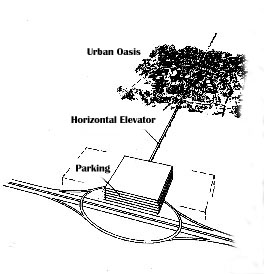The Urban Oasis
TABLE OF CONTENTS
 Chapter 1. The Lost Symbiosis of Urban and
Rural: Explores factors, other than racial, that work to
induce urban flight, and presents arguments--social,
cultural, economic, demographic, and ecological--for the
development of more compact communities within existing
metropolitan areas.
Chapter 1. The Lost Symbiosis of Urban and
Rural: Explores factors, other than racial, that work to
induce urban flight, and presents arguments--social,
cultural, economic, demographic, and ecological--for the
development of more compact communities within existing
metropolitan areas.
Chapter 2. An Apparent Conflict of
Environmental Values: Reviews dilemmas faced when new
development is planned sufficiently high to justify provision
of public transit--planning theory versus planning reality.
Underlines the value attached to the natural environment for
residential location.
Chapter 3. Pi*r2 (Formula for the Area of a
Circle): Explains why local circulation systems, serving
residential communities, must be made efficient and
convenient first, if longer-distance transit patronage is
ever to be realized on a significant scale.
Chapter 4. Pedestrian Zones and Their Place
in the Region: Traces the development of pedestrian
zones in cities, and analyzes elements that have contributed
to, or in some cases detracted from their success. Considers
the potential use of this concept to create new types of
development.
Chapter 5. The Long Electrical Cord:
Outlines the vital advantages of fixed transit guideways and
automated operation in meeting the criteria that were called
for in chapter 3, and in making readily accessible the
pedestrian zone development projected in chapter 4.
Chapter 6. The Urban Oasis: A Tower
Extended: Contains proposals for "urban
oases", five basic variations on the theme, illustrated
with drawings, model photos, and montages.
Chapter 7. Capillaries and Connections:
The regional application of urban oases is demonstrated,
together with the timing of trips from within the oases to
longer-distance, area-wide transportation networks. A variety
of automated guideway transit types are introduced.
Chapter 8. Less Is More: Descriptions of
these systems are further developed. The relative simplicity
of those systems which would be appropriate for urban oases
is clarified, and is differentiated from full-scale automated
metros, and from higher-tech concepts for small, personal
automated vehicle systems with selected service.
Chapter 9. Equilibrium: Discusses some
of the means available for effecting these proposals. It also
comes full circle back to issues of urban policy that were
reviewed in chapter 1.
Appendix: Selective Service and Automated
Guideway Systems:
Further defines the distinctions between those guideway
systems that would be most appropriate for urban oases, and
the more "PRT" concept, which would, in fact, be
irrelevant to their purpose.
As the intent is to describe the interrelationships and
unity among the various subjects in this book, each is of
necessity touched upon in a relatively summary way. The
footnotes invite the curious reader to explore these issues
further.
 Chapter 1. The Lost Symbiosis of Urban and
Rural: Explores factors, other than racial, that work to
induce urban flight, and presents arguments--social,
cultural, economic, demographic, and ecological--for the
development of more compact communities within existing
metropolitan areas.
Chapter 1. The Lost Symbiosis of Urban and
Rural: Explores factors, other than racial, that work to
induce urban flight, and presents arguments--social,
cultural, economic, demographic, and ecological--for the
development of more compact communities within existing
metropolitan areas.